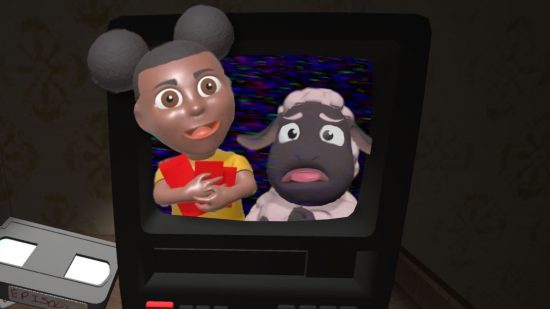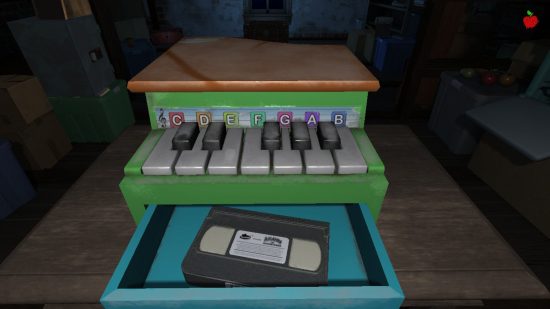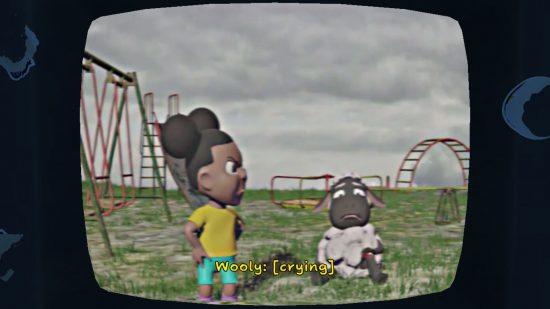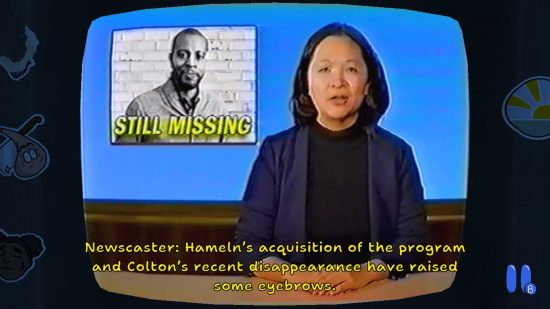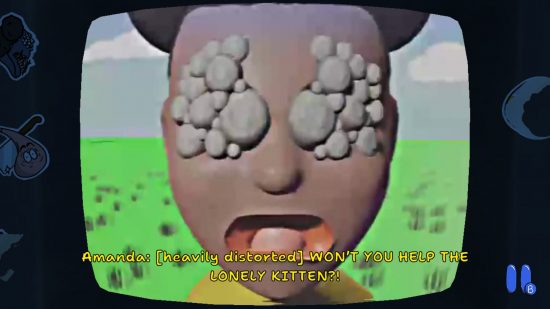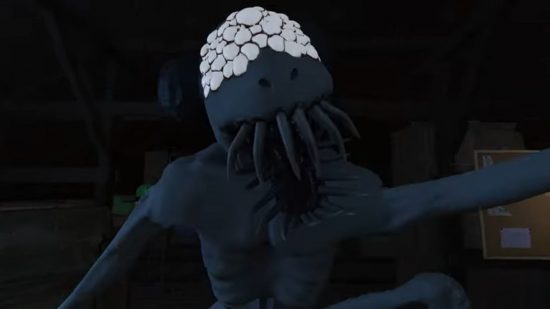Amanda the Adventurer is a weird one. It’s a very simple game, with simple mechanics, a simple world, and predominantly simple puzzles. But one part of it is not simple – and that’s the deep, dark well of lore that makes up its foundation. That’s what’s made it so difficult for me to write an Amanda the Adventurer review – how can you score a game based on the normal parameters when its cultural impact and the discussions around it are such an important part of its true identity?
As such, I’ve decided to dash aside the idea of a traditional review and kick off the spooky season in a different way, only going over the basic review points and then diving into my experience with it and how a game can become a bigger entity than its base form through lore and external theories… Just like Amanda (or Rebecca) herself.
Like many of the indie horror games that came before it, including the Poppy Playtime games, the FNAF games, and even Bendy and the Ink Machine, Amanda the Adventurer’s name and story precedes the game itself. Many of you may have heard about the dark and tragic tale behind Amanda the Adventurer’s Wooly and the titular character herself, be it through the incredibly popular Game Theory videos or let’s plays from iconic Youtubers like Markiplier, Jacksepticeye, or CoryxKenshin, without ever getting the chance to touch the controller. I was one of those people. Was, until I got my paws on an Amanda the Adventurer Switch copy.
It’s an interesting experience, watching hours of content about a game you’ve not yet played, picking apart the lore in your head, and searching frames for little hints that could point to the truth behind the narrative. It’s even more interesting playing said game after you think you know everything about it, putting yourself in the seat of the content creators and giving it a go for yourself.
While, naturally, this process includes having parts of the story spoiled for you before you can dive in yourself, it somehow feels as though it adds a new level of interactivity – almost like an ARG. And, if you take a look at my beginner’s guide to ARGs, you’ll know that’s entirely my jam.

Another thing that Amanda the Adventurer has in common with Poppy Playtime, FNAF, and other such indie games, is the perversion of the innocent or mundane – i.e. children’s media, toys, and other things that are otherwise considered safe and friendly becoming the real threat of the game.
This, along with the concept of ‘analog horror’ that Amanda falls into so well, appears to be the flavor of the month – or, more accurately, the flavor of the past decade – but it’s fascinating to see how different developers approach the topic and manage to make their creations stand out. As, while they all do have a similar vibe and could definitely fit under the same umbrella, these iconic IPs do continue to stand out on their own, and Amanda the Adventurer is no exception.
To summarize Amanda the Adventurer as briefly as possible, it’s a horror puzzle game revolving around interactive VHS tapes of a Dora the Explorer-esque kid’s show from the late 1990’s to the early 2000’s. But, of course, a brief description is never going to truly portray the depth of the story, so let’s go a little further. You play as Riley, who receives a letter from her Aunt Kate after she passes away. In the letter, Aunt Kate informs you that she’s left you her house, while also pointing to a mysterious tape in the attic that she hopes you’ll investigate. However, your aunt makes it clear that, should you watch the tape, there’s no going back.
The game takes place in the attic of the house you inherit. You’re surrounded by a variety of objects such as a toy oven, an old grandfather clock, a safe, a toy robot, and more – though everything really centers around the old CRT TV with a built-in VHS player at the back of the room, and, of course, an Amanda the Adventurer VHS tape sitting on the table next to it. The main gameplay feels like a mix of walking simulator, puzzle, and point-and-click game, as you walk around the small, 3D room pointing at things with your cursor, picking them up to investigate them, and working out how to use them to progress.
Progression is tied to unlocking tapes and uncovering more information, though the order in which you watch the tapes and solve the puzzles sometimes has an impact on the content of the tapes as well. In addition to the Amanda the Adventurer episode tapes, there are also secret lore tapes that give you a peek behind the curtain at the dark, underlying narrative. There are also five endings for you to get, each having slightly different requirements, and some requiring you to finish other endings first in order to carry through the information you discover, such as PINs, secret codes, and specific answers.
The puzzles are generally quite easy if you’re perceptive enough to keep an eye on the details in the tapes and the attic room around you, though they’re still pretty creative at the same time. For example, the puzzles revolving around the meat pie and Blabbot are quite original, and feel satisfying when you put together all the pieces. However, there are a few pretty obtuse sequences integral to unlocking certain secrets or endings that are easy to miss unless you’re familiar with the game or using a walkthrough.
When watching the tapes, Amanda often stops to ask you to point out specific locations or items, or to answer her questions. If you choose or answer correctly, the tape progresses. However, giving incorrect answers can lead to Amanda altering her response, with some situations infuriating her and causing the tapes to glitch out, or giving you unique and harrowing replies.
On the PC version, you give most answers by typing them over a Hangman-esque series of underscores. On the Switch version, you have a set of answers to choose from. Both versions have their pros and cons. In a way, being able to freely type your answers opens up the possibilities, and may, in turn, increase your chances of getting it wrong and upsetting Amanda, adding to the overall anxiety of the situation. On the other hand, the answers on offer in the Switch version are often quite easy to work out through a process of elimination.
However, technologically, it makes more sense to me to have multiple-choice options. As a CRT TV and VHS setup, it doesn’t make much sense being able to type answers, whereas, as a 90’s baby, I distinctly remember old TV games where you could choose answers to questions with your TV remote, so it feels a little more real. Additionally, nothing’s stopping you from choosing the wrong answers to see what will happen in the Switch version, be it annoying Amanda enough to see some creepy images, or answering her with a unique word that triggers the game to give you a new lore tape or cutscene.
There’s another bizarre difference between the PC and Switch version, and that’s how to get one of the secret tapes. Usually, if you type ‘nobody’ in when Rebecca asks you who can help Wooly in the first ‘Oh No! Accidents!’ tape, she dejectedly agrees, and a lore tape appears behind you. However, after many attempts, I found that ‘nobody’ never came up as an option. That is, until I completed the birthday segment and received the altered version of the ‘Oh No! Accidents!’ tape where Amanda says ‘sometimes nobody can help’.
I then had to go back on my next gameplay loop and watch the original ‘accidents’ tape, at which point the ‘nobody’ answer came up. Initially, this frustrated me, as I knew that I needed all the tapes to get one of the endings, and even after scouring multiple walkthroughs, I couldn’t work out why the answer wasn’t coming up. However, in a way, I look back and think of that as quite a clever decision. It’s similar to trying to enter codes into Blabbot in a playthrough where you haven’t got the cake and cards yet, Blabbot says ‘yes, but where did you find that’ and doesn’t let you proceed. These restrictions, in a way, put you through the paces and makes sure you’re exploring all the content rather than simply entering codes and information you find online.
Anyway, enough review talk. Let’s get onto the main part I want to discuss – how the lore of the game far transcends the simple gameplay loop. Throughout the game, you can find multiple tidbits of information, even beyond the secret lore tapes. These include newspaper clippings, letters, books, and more. These cleverly constructed pieces of information do a great job of answering some questions, then replacing them with even more questions – and that, in my opinion, is what makes this game so effective. Right, spoilers ahead, so keep that in mind.
If you’re paying attention, it’s easy to put together a basic understanding of the narrative. Riley’s aunt, Kate, was a librarian in the town that Amanda the Adventurer originates from. Amanda the Adventurer started as a live-action show that a man named Sam created, and he was inspired by his adopted daughter, Rebecca, who played Amanda in the show.
After seeing such success among the locals, likely due in no small part to Kate suggesting it to all the children and parents who visited her library, a large company approached Sam and asked for the rights to turn the show into a cartoon that would be broadcast nationwide. Sam, obviously excited that his sweet little project was gaining so much attention, agreed. Rebecca continued to voice Amanda, and the show became a hit. But it appears that the company behind the newly revamped Amanda show, Hameln (a nod to the Pied Piper who leads children to their doom, as further supported by the rodent logo and tagline ‘follow us to fun’) had darker ideas.
We get little snippets beyond that – the show started changing, with Amanda making inappropriate comments and talking about dark topics. After a while, it also appeared to have a trance-like effect on children, leading to a lot of them going missing. There’s footage of the Hameln director making Rebecca repeat words that sound like demons from the Ars Gotier – pie man is Paimon (no, not Genshin Impact’s Paimon, her association with the demonic is a different topic entirely), bye yell is Bael, and baa lamb is Balam, with Sam getting increasingly upset at the situation. Sam also goes missing, supposedly leaving Rebecca alone, and seemingly making her outbursts in the show much worse.
This is just the tip of the iceberg, but it seems to be a pretty big allegory for ‘corporation = bad’, suggesting that Hameln took over Amanda the Adventurer with malicious intent, derailing it from the sweet kid’s show it originally was in favor of using it to lure in kids and perhaps even summon demons, like the deformed version of Amanda that we see in the Gruesome Ending. There are also plenty of implications that Hameln disposed of Sam after he started asking questions, and that the real Rebecca’s soul is trapped in the tapes, with her body either dead and decaying or trapped in a coma.
However, despite there seemingly being so much content laying down the lore of the game, most of the questions still don’t have a conclusive answer. Is Amanda dead or alive? What happened to the kids – are they the moving objects with eyes in the show, or have they been taken by the demons? Is the monster really Rebecca/Amanda, or is it simply masquerading as her? Who is Wooly? What happened to Sam? There’s just no closure. And that’s exactly what works in this game’s favor.
I remember in university, one of my favorite essays that I wrote was about the human quest for closure, and whether closure is actually as satisfying as leaving unanswered questions and coming to your own conclusions. I never thought that topic would be applicable to my job nearly a decade down the line, but I think that concept is exactly what’s at play here.
In games where everything is answered for you, there’s very little to discuss. However, in games like Amanda the Adventurer, and, of course, the iconic FNAF and Poppy Playtime series, the real thing that makes them so successful is the open endings and opportunities to theorize and come to your own conclusions – be it predicting what will happen in future entries, or trying to tie up the loose ends to satisfy your own sense of curiosity. This, once again, enhances the level of interactivity, and makes the game much bigger than a simple puzzle-based horror game.
From its early itch.io demo from the Found Footage Game Jam (that’s a whole different topic that I won’t dive into today), Amanda the Adventurer captured the eyes of many, attracting big content creators to theorize about the meaning behind each element, and that infection spread to people all over the world. Even today, so long after Amanda first introduced herself to the internet, you can still find people arguing over whether the weird white blobs over Amanda’s eyes are wool or an EEG headset, whether Sam is Wooly or Amanda’s long-lost brother, what on earth is going on with the butcher’s shop, and more.
So, no, I can’t give this game a normal review score, because it’s not just a game. It’s a talking point. It’s a story. And it entirely depends on the type of person you are as to whether you’ll get any value out of it. Amanda the Adventurer’s gameplay is simple, it’s easy, and it performs great on all platforms. It looks nice, and it captures the aesthetic perfectly. But the true horror of this game is in the expertly written narrative; how it spreads into our homes through YouTube videos, forums, and more – just as the demon spreads through the tapes. And for that, it deserves all the kudos it can get.
Anyway, I’ll stop waxing poetic about the immense impact horror games can have on us now. You never know, maybe we’ll be back here discussing the Amanda the Adventurer 2 in a year or so.
If you want to check Amanda the Adventurer out for yourself, it only costs a few dollars on Switch or Steam, and it really does feel different when playing it yourself. Outside of that, be sure to check out our list of the best Halloween games on Switch and mobile, or take a glance at some ghastly ghouls in our FNAF characters, Poppy Playtime characters, or Poppy Playtime Chapter 1 and Poppy Playtime Chapter 2 walkthroughs.
